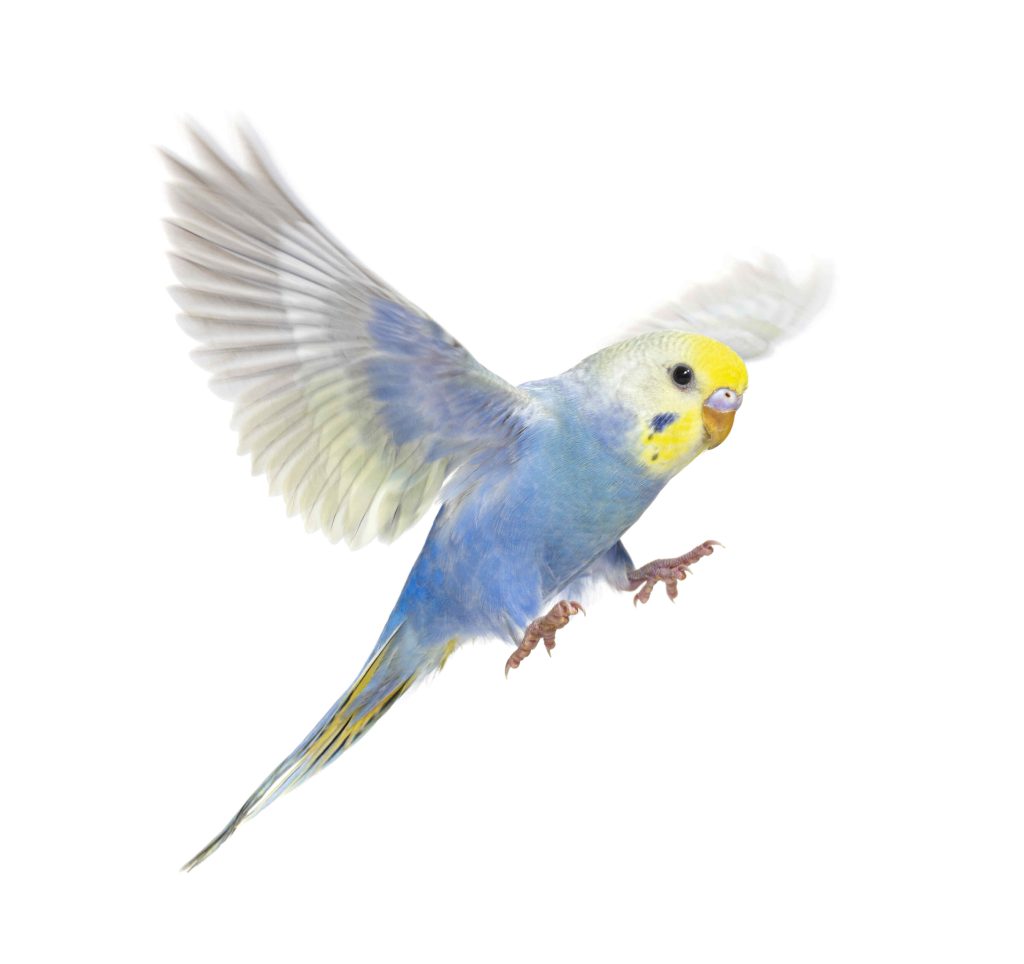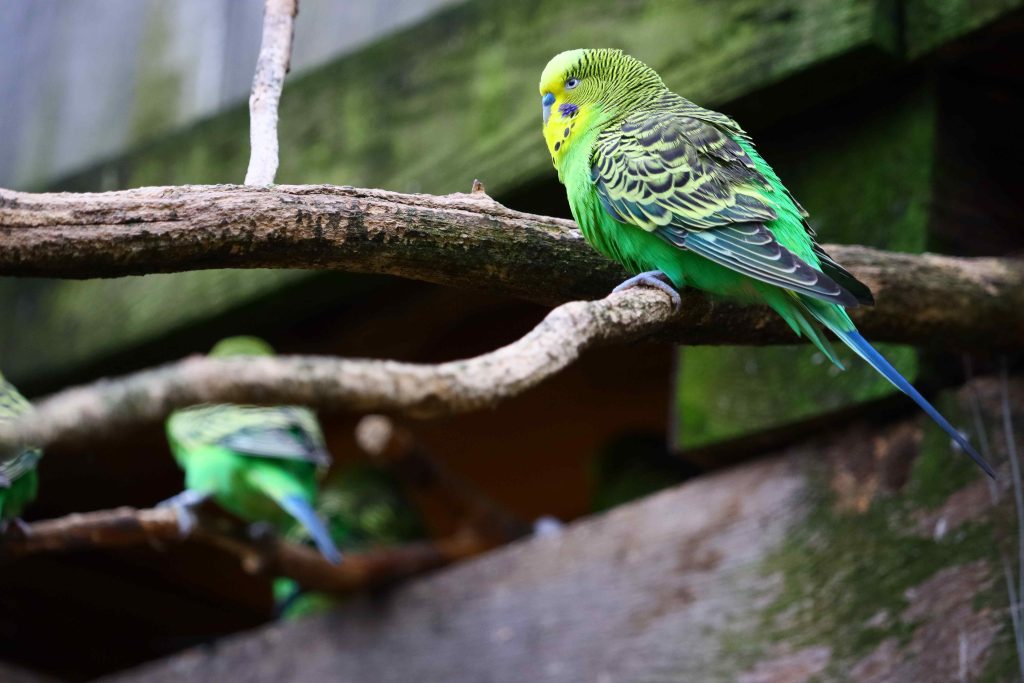The budgie is a popular pet when people are looking for a pet bird. They are small, their upkeep isn’t as complicated compared to some other pets, and they are able to mimic human speech. It’s said that budgies are the third most commonly kept pet in the world, after dogs and cats. Through this guide we hope to inform (potential) budgie owners about the care they require to stay happy and healthy.
About the budgerigar
The official name of the budgie is the budgerigar, but they are more commonly known as (grass) parakeet or budgie. They are native to parts of Australia where they live in flocks and have a nomadic existence by moving from site to site as environmental conditions change. Their natural colours are green, yellow and black, but in captivity you will find them in all kinds of colours like blue, white, violet, yellow, and grey. Budgerigar are small seed-eating parrots, and their total length from top to tail ranges from 18 cm to 20 cm and they weigh from 30 to 40 grams. All juveniles and chicks are born with a pink cere (the area containing the nostrils) which will change colour as they age. For females the cere will turn brown/pale brown and the male’s cere will turn blue. Budgies have a lifespan of 5 to 10 years, averaging at approximately 7-8 years.

Cage
Before deciding what would be a good size cage for your budgie, you will first have to determine how much time your budgie will spend in its cage. As budgies get most of their physical exercise out of flying you will need to provide them the opportunity to do so. If you don’t have much opportunity to let them fly freely, at least a few hours daily, you should consider getting a flight cage. Flying will keep your budgie healthy and happy. As budgies fly horizontal, keep this in mind when choosing a cage. While some narrow upright cages might look nice, they will not be the best choice for your budgie. Prevent round cages as the lack of corners creates anxiety in some birds.
The general consensus is that for budgies that spend a considerable amount of time out of their cage a 46x46x46 cm cage for 1 budgie suffices. For 2 budgies this is 77x46x46 and for 3 82x46x51 cm. For every additional budgie add 62271 cubic cm. Bigger is always better. If you can’t let your budgies fly freely outside of their cage, an aviary is the only option. There are more things to keep in mind when setting up an aviary besides size, like making sure you can keep your birds warm/cool as most of the time aviaries are placed outdoors. If you wish to set up an aviary, consult with a professional on the best way to do so.
Budgies need a wire cage to prevent them chewing their way to freedom. The bars can be either horizontal or vertical. Make sure that the bars are close enough to each other that your budgie can not squeeze its head through, which will be about max 12mm between each bar. Make sure the cage has no sharp points or edges, or bars that get closer towards each other at some points. This is because they might slip in with their leg and get hurt trying to escape. If you have a cage where the door slides open without a safety latch, consider installing one yourself as budgies are smart and will learn how to slide the door open. Besides that this will be an opportunity for them to escape, the door can also fall on them when they try to open it.
When choosing a cage, pick one that is easy to clean. The cage will need spot cleaning daily, and depending on the cage liner you use it might need to be either changed daily, or atleast spot cleaned. Water and fresh food bowls need to be cleaned daily. If you have a bird bath this will need to be cleaned and filled with fresh water. Clean the whole cage every week with soapy water and make sure to rinse it well. Don’t use toxic cleaners.
Place the cage of your budgie in a spot where your family spends most of their time. Pick a location for the cage that is not in direct sunlight or in a draft. Avoid placing the cage in the kitchen as cooking fumes can be toxic to your budgie. Your budgie will feel most safe if its cage is placed against a wall or in a corner.
Exercise and Enrichment
Inside the cage provide your budgie with perches to sit on. By choosing a different thickness in perches you can prevent the pressure on the foot always being on the same point. If you have the possibility you can make your own perches from non-toxic trees. Make sure they are not sprayed with chemicals or from trees near busy roads. Otherwise you can buy branches from the pet store. Plastic, sand and concrete perches are unsuitable for your budgie and should be avoided as they will increase the risk of bumblefoot and sores on the feet of your budgie. The same issue arises with round dowel perches, but these can be used if you also provide sufficient other perches. Perches you can use are natural perches, calcium perches, rope perches and safe pumice perches. By using different types and thicknesses of perches you can provide your budgie with enrichment within the cage and give their feet the exercise they need to stay healthy.

Another great way to provide enrichment is by offering toys to your budgie. Favourite treats can be hidden in toys which will make your budgie have to think about how to get to their treat. Budgies are ground foragers. You can buy a fake grass mat and scatter seeds in it. You can also scatter some seeds in the bottom of the cage. Enrichment can also be provided outside their cage. You can hang toys from the wall or ceiling where your budgie can fly towards and play with. You can make a play stand with toys to explore and climb in. There are special clips available to hang greens, cuttlefish and millet spray in, which can be used inside and outside the cage. By moving these around you can make your budgie work and think. Make sure that all the materials you use are non toxic.
Budgies are extremely smart, and can be taught tricks through positive reinforcement training. Working together with your budgie is not only a great way to provide them with mental stimulation, it will also strengthen the bond with your budgie.

Feeding
For feeding you will need four bowls, one for water, one for seeds, one for pellets, and one for fresh salad. If the feed/drink bowls don’t have a spot to sit on, make sure to put a perch close so your budgie can reach the bowl. Prevent placing perches above the bowls as they will poop into their bowls.
A common mistake seen when people choose a diet for their budgie is feeding a seed only diet. As seeds are high in fat, this is an unsuitable diet as it increases the risk of developing fatty tumours and fatty liver disease. It’s true that in the wild budgies mainly eat seeds, but they also fly great distances daily to burn all the calories they consume, which is not the case in captivity.When budgies eat seeds, they will leave the husks in their bowl. Be sure to remove the empty husks daily. An easy way to do this is by blowing them out. Besides seeds, the daily menu of your budgie should consist of:
- A good quality pellets (unlimited)
- Small amount of seeds (1 teaspoon or less)
- Fresh salad mix consisting of vegetables and a small amount of fruits, legumes and grains.
An example of a basis you could use for the salad is:
- 1 to 2 orange veggies, like butternut squash, carrot, pumpkin and sweet potato.
- 1 dark leafy green vegetable, like kale, collard greens, broccoli and dandelion greens.
- 2 to 5 “other” veggies like pees, beet root, bell pepper and cauliflower.
You can add on occasion:
- Grains, like Quinoa, barley and steel cut oats.
- Legumes (soaked and cooked), like green beans, black eyed peas and black beans.
- Fruit (remove pits), like mango, blueberry, cherry and papaya.
Salad mixes can be batch prepared and frozen, though some birds might not eat defrosted salads. Some birds will prefer whole foods instead of small chopped pieces. Birds can be picky eaters so see what works for your budgie through trial and error.
Foods to avoid are: avocado, asparagus, rhubarb, mushroom, comfrey and dairy products. Above are not complete lists, so if you wish to feed something to your budgie you are unsure of, make sure to research well if it’s safe to do so. Most budgies love spray millet as a treat.
Social and taming
To gain the trust of your budgie you can talk to them, sing to them and live your daily life close to them. Some budgies get tamed fast, while for others it may take way longer. In general young birds tend to be tamed faster than older birds, and single birds are easier tamed than those kept with other birds. If you keep your budgie alone, be the companion it needs. If you don’t have much time to spend with your budgie (at least a few hours a day), or they seem lonely regardless, get them a friend.
Care
You don’t need to groom or bathe your budgie. By providing them with a clean water source, like a running tap or bird bath they will bathe themselves. You can also use clean water in a spray bottle to spray your budgie slightly moist. Do not use soap. Some budgies won’t like bathing and that is totally fine, they can keep themselves clean perfectly and don’t need to bathe to stay healthy.
Your budgie’s nails should require minimal clipping if you use natural perches, and preferably this is only done if they keep getting stuck in things or make your bleed when sitting on you as long nails help with grip and balance. Another sign their nails are too long is when they stand on a flat surface and their (curled) nails prevent their feet from going totally flat on the floor. You can find a guide to nail clipping in our blog “Understanding Pet Nail Care“. If you don’t feel comfortable clipping the nails of your budgie, your avian veterinarian will be able to help. Some groomers might also be able to do this for you but make sure they are experienced in clipping bird nails.
Keep in mind that certain fumes will be extremely toxic to your bird, like fumes that happen when cooking in nonstick pans and anything that has an aerosol propellant in it.
Keeping budgies as pets
These tiny parrots can make lovely pets and with the right care can be a great addition to the family. We hope that through this guide we have informed those interested in budgies about their care, so that not only the new budgie owner will be happy with their new pet, but their budgie can lead a happy and full-filling life.
Did you know we also pet sit budgies? Our pet sitters are knowledgeable about budgerigars care and will love your budgie like it’s their own. Feel free to contact us for more information about our pet sitting service.

